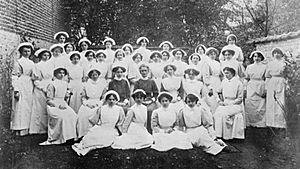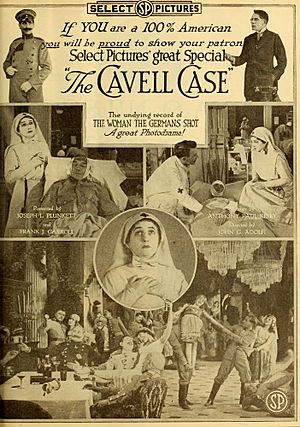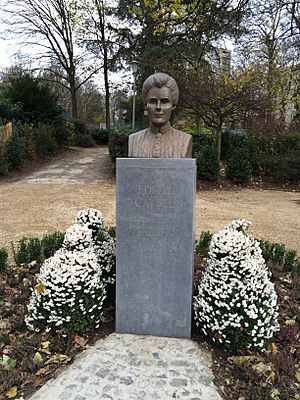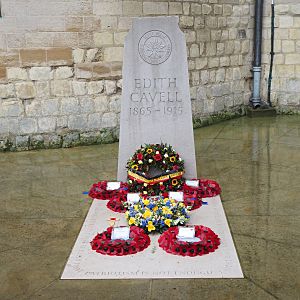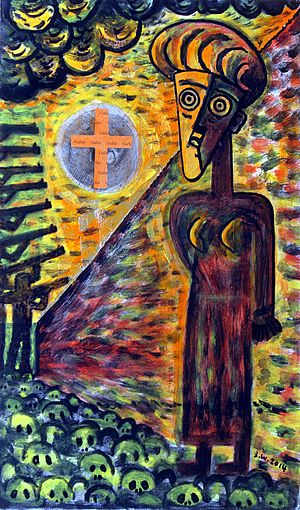Edith Cavell facts for kids
Quick facts for kids Edith Cavell |
|
|---|---|
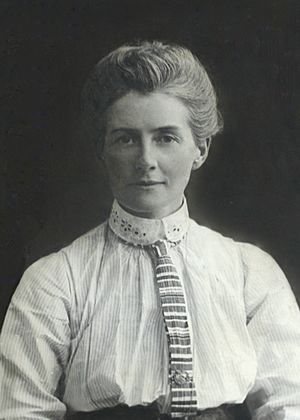 |
|
| Nurse | |
| Born | 4 December 1865 Swardeston, Norfolk, England |
| Died | 12 October 1915 (aged 49) Tir national (National Shooting Range), Schaerbeek, Brussels, Belgium |
| Venerated in | Church of England |
| Feast | 12 October (Anglican memorial day) |
Edith Louisa Cavell (KAV-əl; 4 December 1865 – 12 October 1915) was a brave British nurse. She is remembered for helping soldiers from both sides during the First World War. She also helped about 200 Allied soldiers escape from German-occupied Belgium. Because of this, she was arrested by the German army.
She was accused of helping the enemy, found guilty by a military court, and sentenced to death. Even though many people around the world asked for her to be spared, she was shot by a German firing squad. Her death caused a lot of anger and was reported in newspapers everywhere.
The night before she died, Edith said, "Patriotism is not enough. I must have no hatred or bitterness towards anyone." These famous words are now on a memorial built for her in London. Her strong Christian beliefs made her want to help everyone who needed it, whether they were German or Allied soldiers. She once said, "I can't stop while there are lives to be saved." The Church of England remembers her on 12 October each year. Edith Cavell was 49 years old when she was executed. She was already well-known for being a leader in modern nursing in Belgium.
Contents
Early Life and Nursing Career
Edith Cavell was born on 4 December 1865 in Swardeston, a village near Norwich, England. Her father was a vicar there for 45 years. She was the oldest of four children.
She went to school at Norwich High School for Girls and other boarding schools. After working as a governess (a private teacher) in Brussels from 1890 to 1895, she returned home to care for her sick father. This experience made her decide to become a nurse.
In 1895, at age 30, Edith began her nurse training at the Royal London Hospital. She helped during a typhoid outbreak in Maidstone in 1897. After her training, she worked as a private nurse, helping patients in their homes. Later, she became a night superintendent at St Pancras Infirmary and then an assistant matron at St Leonard's Infirmary.
In 1907, Edith Cavell moved to Brussels, Belgium. She was asked to be the head nurse (matron) of a new nursing school called L'École Belge d'Infirmières Diplômées. By 1910, she even started a nursing magazine called L'infirmière. Within a year, she was training nurses for many hospitals, schools, and kindergartens across Belgium.
First World War and Arrest
When the First World War started, Edith was visiting her mother in England. She quickly returned to Brussels. Her nursing clinic and school were then used by the Red Cross to help wounded soldiers.
In November 1914, after Germany took control of Brussels, Edith began helping British soldiers. She helped them escape from occupied Belgium to the neutral Netherlands. Wounded British and French soldiers, as well as Belgian and French civilians who were old enough to fight, were hidden from the Germans. They were given fake papers and guided to safe houses, including Edith's home. From there, they were given money and guides to reach the Dutch border.
This help meant Edith was breaking German military law. German authorities became suspicious of her actions. She was arrested on 3 August 1915. Someone named Georges Gaston Quien had told the Germans about her activities.
Edith was held in Saint-Gilles prison for ten weeks. For the last two weeks, she was kept alone. She admitted to the German police that she had helped about 60 British and 15 French soldiers, and about 100 French and Belgian civilians, escape to the border. She also said she had hidden most of them in her house.
At her military trial, she was accused of helping British and French soldiers, and young Belgian men, cross the border into the Netherlands and then to Britain. She admitted she was guilty. Edith said the soldiers she helped escape had thanked her in letters once they were safe in Britain. This confirmed she had helped them escape to a country that was at war with Germany.
Under German military law, the punishment for such actions was death. Even though the United States (which was not yet in the war) tried to help, the British government could do little. Some German officials wanted to pardon Edith because she had been honest and had saved many lives, including German ones. However, the military governor of Brussels ordered that she and another person, Philippe Baucq, be executed right away.
Edith Cavell was not arrested for spying, as some people thought. She was arrested for "war treason" because she helped enemy soldiers.
Execution
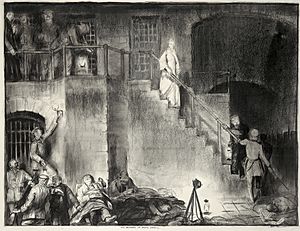
The night before her execution, Edith spoke to the Anglican chaplain, Reverend H Stirling Gahan. She told him, "I am thankful to have had these ten weeks of quiet to get ready. Now I have had them and have been kindly treated here. I expected my sentence and I believe it was just. Standing as I do in view of God and Eternity, I realise that patriotism is not enough, I must have no hatred or bitterness towards anyone." These words are carved on her statue in London.
Her last words to the German prison chaplain, Paul Le Seur, were, "Ask Father Gahan to tell my loved ones later on that my soul, as I believe, is safe, and that I am glad to die for my country."
Despite efforts from the U.S. ambassador and the Spanish minister to stop the execution, it went ahead. Edith Cavell was shot by a German firing squad at 7:00 AM on 12 October 1915. This happened at the Tir national shooting range in Schaerbeek, Belgium.
After the war, her body was brought back to Britain. A memorial service was held at Westminster Abbey. She was then buried at Norwich Cathedral on 19 May 1919.
First World War Propaganda
After Edith Cavell's death, her story was shared widely in newspapers, pamphlets, and books. She became a very important figure for encouraging men to join the army in Britain. Her story also helped gain support for the Allies in the United States. She was seen as a hero because she was a woman, a nurse, and faced death so bravely.
Her execution was presented as a cruel act by Germany. This was very different from Edith's own wish to have "no hatred or bitterness towards anyone." Some early news reports about her execution were not entirely true. For example, a story spread that she fainted and was shot while unconscious because she refused a blindfold.
The British government used Edith Cavell's story as part of its propaganda efforts. She became the most famous British female casualty of the First World War. Her heroic story and the way she died made her case one of the most powerful tools in British propaganda.
Before the war, Edith was not widely known outside of nursing. This allowed for different ways of showing her in British propaganda. One common image was of Edith as an innocent victim of a cruel enemy. This view showed her as someone who helped soldiers escape but was not a spy. These images were used to make people want revenge and encourage men to join the armed forces.
Another way Edith was shown was as a serious, brave, and patriotic woman who gave her life to nursing and died to save others. This image came from people who knew her. The German army chaplain, Paul Le Seur, said, "Miss Cavell was a very brave woman and a faithful Christian." The Anglican chaplain, Reverend Gahan, remembered Edith saying, "I have no fear or shrinking; I have seen death so often it is not strange, or fearful to me!" Her courage as a non-military woman made her even more famous.
Memorials and Tributes
Repatriation and Burial

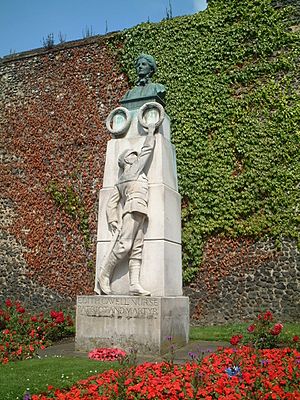

Edith Cavell's body was brought back to Britain after the war. It arrived in Dover on 14 May 1919. Her coffin was then taken by train to London for a state funeral at Westminster Abbey. Finally, she was buried at Norwich Cathedral on 19 May. A special permission was needed for her to be buried there. A stone memorial with a statue of Edith Cavell was later put up near Trafalgar Square in London.
Centenary Events
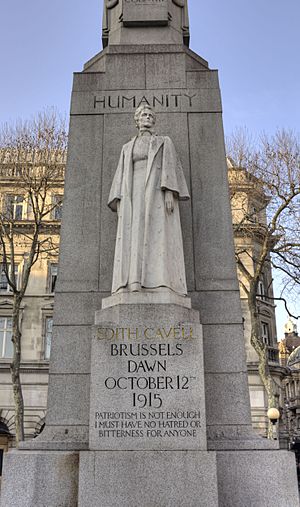
In 2015, to mark 100 years since her death, Edith Cavell's grave at Norwich Cathedral was restored. Fourteen paintings by Brian Whelan were created for Norwich Cathedral to remember her life and death. A special memorial service was held at the cathedral.
New musical pieces were also created to honor her. A 40-minute musical work called Eventide: In Memoriam Edith Cavell was performed in Norwich Cathedral and London. Another musical piece was performed in Brussels, in the same church choir stalls where Edith sang in 1915.
Edith Cavell was featured on a special UK £5 coin in 2015. A bust (a statue of her head and shoulders) was unveiled in Belgium by Princess Anne of Great Britain and Princess Astrid of Belgium. In 2018, a Google Doodle celebrated her 153rd birthday.
Other Memorials
Many memorials around the world remember Edith Cavell. A patriotic song called "Remember Nurse Cavell" was released in 1915. Mount Edith Cavell, a large mountain in Canada, was named after her in 1916. Memorial gardens are dedicated to her in Scotland and Australia.
The Church of England remembers Edith Cavell on 12 October each year. This is a special day to honor her. In 2022, she was also added to the Episcopal Church liturgical calendar.
Her name is on war memorials in Salford, England, and in Schaerbeek, Brussels, Belgium. A portrait of her is in a mural of heroic women in a church in London. Her home village of Swardeston still holds an annual flower festival in her memory.
There are memorial plaques for her in Peterborough Cathedral and St Leonard's Hospital in London. A blue plaque marks a cottage in Norfolk where she spent holidays. A joint memorial to Edith Cavell and Marie Depage is in Brussels. A stone memorial to her in Paris was one of two statues that Adolf Hitler ordered to be destroyed in 1940.
The famous French singer Édith Piaf was named after Edith Cavell. The name "Édith" became more common in France after 1915.
Films, Plays, and Music
Many films and plays have been made about Edith Cavell's life:
- The first film was the 1916 Australian silent film The Martyrdom of Nurse Cavell.
- Dawn (1928) and Nurse Edith Cavell (1939) were two films by Herbert Wilcox.
- Plays like Edith Cavell, Nurse and Martyr and "Patriot" have told her story on stage.
- She has also been mentioned in TV shows like To Serve Them All My Days and The Crimson Field.
Edith Cavell has also inspired music:
- The opera Edith Cavell by Maltese composer Paolino Vassallo was performed in 1927.
- Songs like "Saint Stephen's End" by the Felice Brothers and "Amy Quartermaine" by Manning include verses about her.
- The song "Que Sera" by O'Hooley & Tidow was also inspired by her execution.
Images for kids
See also
 In Spanish: Edith Cavell para niños
In Spanish: Edith Cavell para niños



